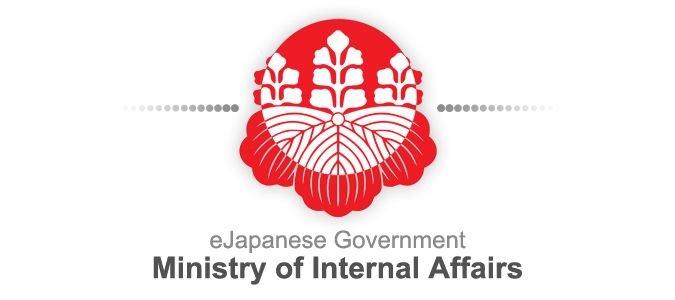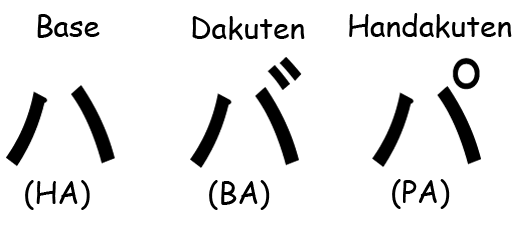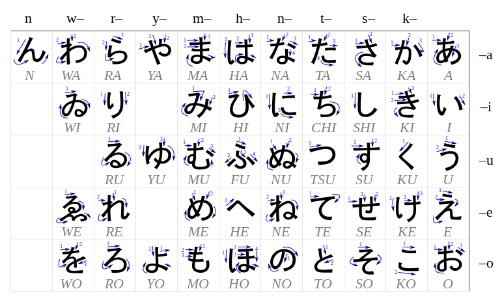[MoIA] Japanese Lessons Pt. 2
 •
by
•
by William of Edenbury

Welcome back all you eager students o/
Last lesson you were shown the basic tables of the Japanese "alphabet". However, many of you will remember the notes that I left at the end about changes in pronunciation. As such today's lesson will be dedicated to pronunciation and its changes.
Basic Pronunciation
first let us go back through the Hiragana vowels and make sure we have the correct pronunciation
あ - A - Pronounced as "Ah" as in "All"
い - I - Pronounced as "ee" as in "Keep"
う - U - Pronounced as "oo" as in "loot"
え - E - Pronounced as "Eh" as in "Met"
お - O - Pronounced as "Oh" as in "Go". Cut the sound off halfway though. Spanish speakers can get this pronunciation a whole lot easier than English speakers because Spanish pronounces it the same way.
Here is a handy recording
With these pronunciations you can get most of the Hiragana because all the following ones include these vowels pronounced in the same way. We will, however, go over some pronunciations that look a little odd though they still follow the rule.
し - Shi - pronounced as "She"
ち - Chi - pronounced as if you were saying "Cheap"
つ - Tsu - This one is difficult for many western speakers because we don't usually use this letter combination. To get the hang of beginning the sound think of saying "What's" from the phrase "What's going on".
ふ - fu - Pronounced as Foo as in "Fool"
ん - N - Pronounced the same way you would use the letter "n" in an English word
Exceptions
Prepare to be annoyed. These two don't follow the rule.
は - This is usually pronounced "Ha", but on certain occasions it changes to sound like "Wa". Remember that we had an issue with this in the last lesson. I do not really know how to tell the difference except by memorizing. Most words use it in the "Ha" form though. This does not include the extremely important particle we will study later that is always pronounced as "Wa".
を - This is pronounced as "O". Every Kana table you will ever see will write the romanji as "Wo" but it is pretty much never pronounced that way in Hiragana form because the Hiragana is almost always used as a certain particle in modern Japanese. The Katakana version ヲ is the exact opposite though. It always sounds like "Wo" as in "Woe".
Dakuten Marks
Also known as "Tenten" Marks, these marks will change the pronunciation of select Kana. That means that certain character in both the Hiragana and Katakana will take them.

The image above gives you an example of the change. Don't worry too much though, that third version called Handakuten only applies to the Kana starting with the "H" sound.
My teacher tried to explain it as the marks "hardening" the sounds of the kana but that never really made much sense to me. I eventually just got it through memorization. Stay with me for a moment though. Google did not want to give me a good image for this so I have to type the examples by hand.

First off, the Dakuten Marks do not apply to all Kana, and as I told you, the Handakuten are even more specialized as they only apply to kana with the "H" sound.
Looking at the image above, the Dakuten will apply to the K, S, T, and H, columns. So lets go over the changes.
K column- The K changes to a G
S column- The S changes to a Z
T column- The T changes to a D
H column- The H changes to a B
So lets add dakuten "tenten" marks to some of the Hiragana
か -> が _______________________________ Ka -> Ga
さ -> ざ_________________________________ Sa-> Za
た -> だ ________________________________ Ta -> Da
は -> ば ________________________________ Ha -> Ba
Now for the weird ones! These do not follow the Rule.
し -> じ _________________________________ Shi -> Ji
つ -> づ _________________________________ Tsu -> zu
Note: We've had a rather long discussion on the exact pronunciation of づ. the "Zu" pronunciation appears to be the most common but we also saw some "dzu" and "du". Google translate for example needs you to type "du" in order to get づ.
And another handy pronunciation help with づ
Handakuten

OK ladies and gentlemen let us finish up with this part. Now we will cover the Handakuten that looks like a circle. This particular mark only effects the Kana starting with the "H" sound. We will go back over the tenten marks as well so you can see all three forms of the "H" kana.
は -> ば -> ぱ ___________________________ Ha -> Ba -> Pa
ひ -> び -> ぴ ___________________________ Hi -> Bi -> Pi
ふ -> ぶ -> ぷ ___________________________ Fu -> Bu -> Pu
へ -> べ -> ぺ ___________________________ He -> Be -> Pe
ほ -> ぼ -> ぽ ___________________________ Ho -> Bo -> Po
Small つ
After that earlier strange pronunciation you probably thought you were done with つ, but you're not
😛
A Small つ ,called Sokuon, in a word acts to double the consonant that follows it. Here are some examples:
いって = Itte _____________ "Speak"
エッチ = Ecchi ____________ "Lewd" (Yup the Katakana version has the same usage)
まっか = Makka ____________ "Crimson"
にっぽん = Nippon _________ "Japan"
あっき = Akki _____________ "Evil Spirit"
Ok everyone I know I promised to go over the Ya, Yo, Yu combinations today but this article was particularly difficult to make and likely to read as well so I am going to give everyone a breather. Next lesson will include the Ya, Yo, Yu and will largely be reviewing these first two lessons after that.


Comments
v
Keep at it Will-san.
v
way to go sensei 😁
Great article.I hope that others like Mofa Mod - will introduce articles about history and culture of Japan /Nippon/にっぽん
Great...
Ta Da
Thanks ❤ V+S